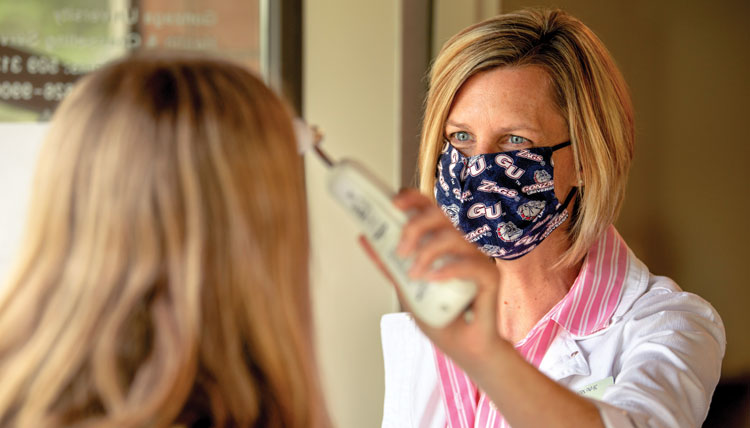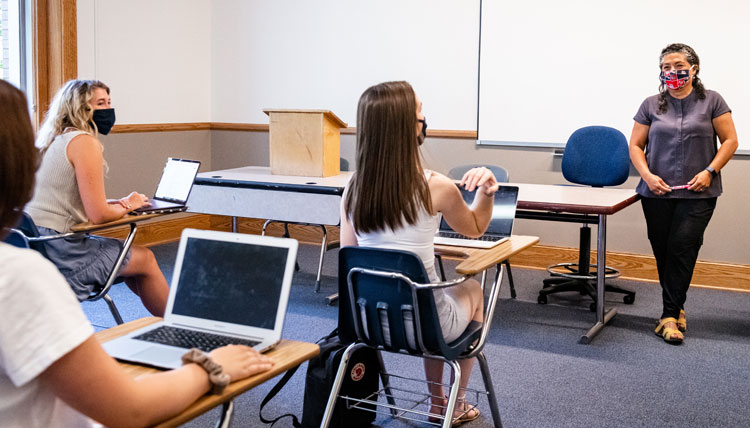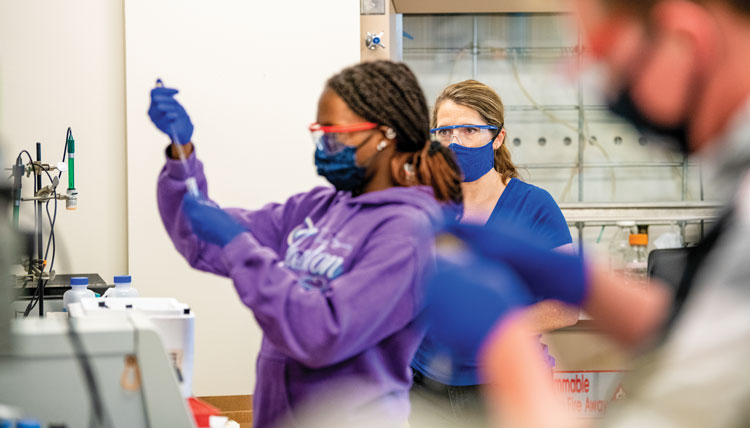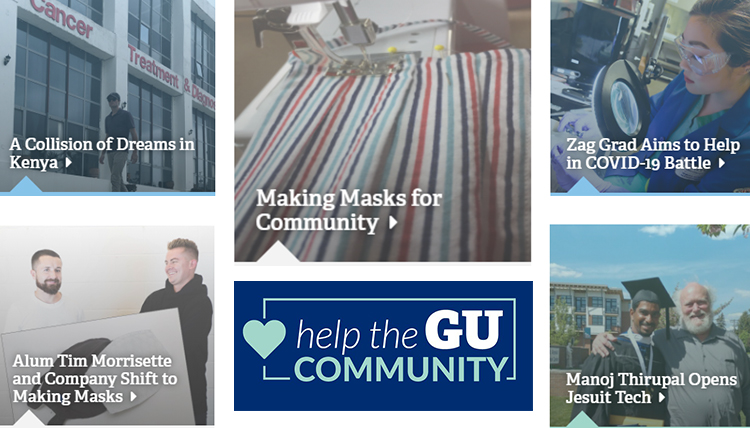Fall 2020 COVID-19 Lessons & Opportunities
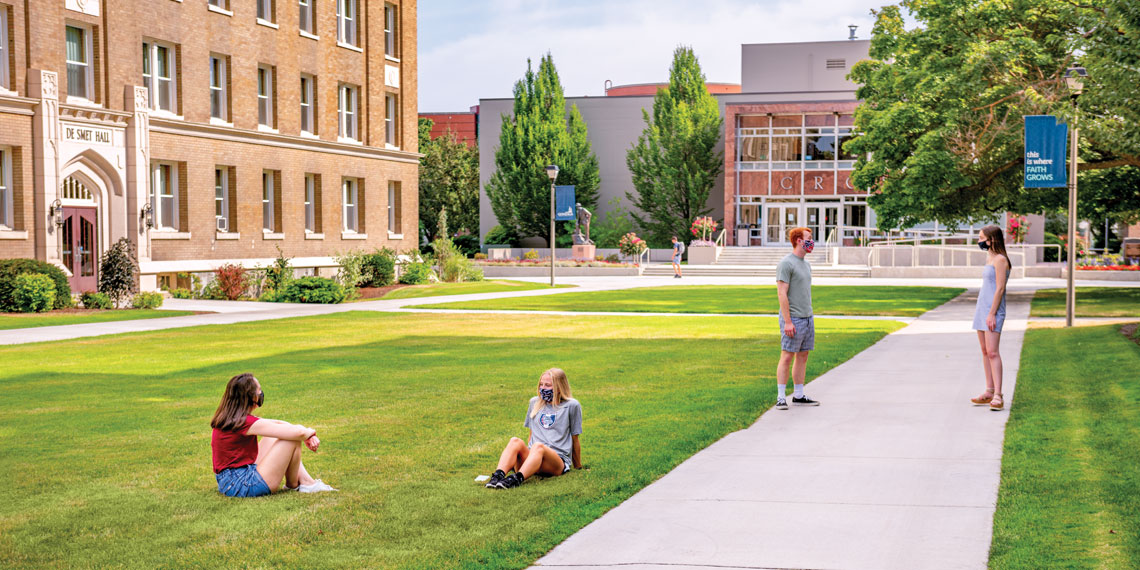
Planning for college activities amid the COVID-19 pandemic was like hitting a rapidly moving target with a cotton ball. As one plan evolved, a new complexity arose, and updated arrangements emerged. But Gonzaga persisted, and on Sept. 1, welcomed a portion of students back to a campus that had been empty for five months.
With the highest priority being the safety and well-being of students, faculty, staff and other members of the campus community, leaders relied on health experts from the CDC, Washington state and the Spokane Regional Health District.
The University’s Pandemic Response Task Force (PRTF) and its 10 committees worked tirelessly to implement protocols for safety, ensure academic delivery would remain the high caliber expected, and plan for every contingency imaginable under such extraordinary circumstances.
Meanwhile, the public debated which measures were necessary and which were violations of personal rights. Perhaps no other national situation in our lifetimes has required such thought and cooperation from a health standpoint while also battling such intensity of diverging opinions.
Quick Pivot
Gonzaga received word in December of a virus outbreak in China, and brought home its two students studying in Beijing during fall semester. In January it became clear that the virus was spreading, and a month later, Gonzaga closed the Florence campus and brought home all study abroad participants.
Spring Break took place in concert with the West Coast Conference basketball tournament, and in Zag tradition, many fans descended on Las Vegas. About that time, enterprises of all kinds began shutting down across the country, and President Thayne McCulloh extended spring break a second week to keep students from returning to campus. On March 13, Washington Gov. Jay Inslee issued a declaration prohibiting colleges and universities from conducting in-person classes, and faculty began delivering classes via remote means.
Making Order Out of Chaos
“Gonzaga is blessed with an amazing array of talented, creative and tenacious people who are willing to bear down and work through complex challenges to develop solutions, keeping the focus where it needs to be,” says President McCulloh. “We are an institution that has learned, over the course of its history, that the unexpected is a part of life and itself an opportunity to learn, adapt and grow. Our ability to quickly move into virtual course delivery was itself the result of our experience in distance-delivery coupled with the development of technology-enabled systems in anticipation of a different pandemic – the H1N1 viral influenza (2009-2010).”
In times like these, Zags help Zags, and it has never been more evident than during the COVID-19 pandemic.
New Experiences
Academic leaders assessed input from faculty colleagues, and evaluated how to maximize class participation through a variety of synchronous delivery methods.
Surveys of families showed a strong preference for returning to campus this fall for in-person learning wherever possible. Some students opted to stay home and take their classes in real time, thanks to new classroom technology. Others alternated between in-person and digital real-time hybrid classes where everyone could participate in lively classroom discussion, regardless of where they were.
Meanwhile, the creative staff of Student Affairs devoted its energies to keeping students engaged in activities, even virtually, to foster the growth that happens when Zags serve, lead, perform and play safely while the battle against the impact of coronavirus wages fiercely.
Health & Safety
Kristiana Holmes, director of Health & Counseling Services, takes a student's temperature.
Among the many details: face coverings, physical distancing, signage everywhere and classrooms reconfigured with reduced capacities. Out of sight but equally important: return-air filtration upgraded to improve indoor air quality, and detailed cleaning protocols to help reduce the spread of the virus.
Communicating with students and families took place through email, text updates, social media and a robust new website. In Town Hall meetings, President McCulloh called students to be “active participants in the work of mitigating transmission.” In video messages, he warned of the risks parties would create – as had already been shown at other universities across the nation – and explained the required daily attestation of symptom monitoring through a new app called ZagCheck, which would also assist in contact tracing.
Even so, McCulloh, Task Force Chair Charlita Shelton and other pandemic task force leaders acknowledge that even the best-laid plans can’t prevent COVID from impacting the campus. There is space for quarantining students who have been in close proximity to an individual who has been diagnosed with the coronavirus, and an isolation unit for anyone diagnosed positive for COVID-19. In both cases, the accommodations are comfortable and equipped with technology to allow students to continue studying and attending classes remotely as long as they feel able to do so.
Class Acts
Over spring and summer months, academic leaders developed a full cadre of resources to equip faculty. The Academic Instruction and Learning Committee, co-chaired by Biology Associate Professor Marianne Poxleitner and Vice Provost Jolanta Weber, worked diligently with Director Justin Marquis of Instructional Design and Delivery and Director Mia Bertagnolli of the Center for Teaching and Advising. All faculty will use interactive technology to reach all students, in class or via distance delivery, during live, synchronous class sessions, delivered at normal class times when possible. Materials are posted online, and the lectures are recorded.
Marquis and Bertagnolli created a Zag-Interactive Best Practices Guide to help every professor prepare for remote delivery of classes, since fall plans stipulated that all instruction post-Thanksgiving would be online, to decrease the chance of holiday travelers bringing illness back to campus.
“Be engaging, and continue the Gonzaga level of academic regimen,” Bertagnolli advises.
“This is not correspondence school,” Marquis interjects. “Use Blackboard, Kaltura and Zoom to make your classes highly relational. Leverage all modes of engagement to make the richest possible experience for your students.”
Faculty have found enterprising ways to make this happen.
Associate Professor Karen Rickel and students engage in in-person learning while maintaining safety protocols.
Assistant Professor of Biology and Biochemistry Wilson Bailey records his lectures on a software app called Explain Everything and exports three or four 10-20-minute lectures during every class, allowing students to stop the recording, go back and review for understanding at their own pace.
English Associate Professor Chase Bollig refocused his thinking from course outcomes to learning experiences. Considering that some students are facing unexpected mental and physical health issues, he created a work-reduction plan. It allows students to juggle all that’s on their plates to complete the remaining assignments as their time allows, participate in online discussions, keep up with the readings, stay in touch with the instructor, but be excused from class attendance.
Students recognize and appreciate the efforts teachers are making to keep them engaged and supported. When classes and labs moved online in March, mechanical engineering graduate Bunji McLeod (’20) appreciated his professor, Derek Larson, for shifting his lab focus from work on prototypes and equipment in the machine shop to being a valuable resource for networking for engineering jobs. Business grad Kate Michelon (’20) was impressed by the “person-first” attitude so many professors took during transition to remote learning, making sure to check how every student is doing.
“Our biggest challenge is to ensure our community is all on the same page in regard to protocol. We need to hold each other accountable, to make sure people on our campus stay safe. Let’s be part of the solution, not part of the problem.”
- Charlita Shelton, Chair, Pandemic Response Task Force
With an Ear to the Ground
Through these ever-changing months of the pandemic, Director Amy Swank of the Parent and Family Relations office has talked with many parents who are grateful for the “thoughtful intentionality that the University, pandemic task force, staff and faculty are putting into creating a safe space for their students. I think many families also recognize the value of an on-campus experience and are hopeful that we will be able to continue offering on-campus, face-to-face education.
“But with all the uncertainty, it’s been challenging to comfort and support their student because even as parents, protectors and caregivers who often times have the answers, COVID-19 and this global pandemic have made it so that even the most trusted advisers don’t have the answers or wherewithal to guide their Zag during this situation,” Swank says.
While safety is the major concern, students and families also wonder what student life on campus will look like this fall.
“Our intent is to provide a mix of in-person and virtual programs and activities in Student Affairs,” said Vice Provost for Student Affairs Kent Porterfield during the summer. “Our primary focus is the safety and holistic well-being of our students, promotion of equity and justice, and building community.”
Meanwhile, recruiting the class of 2025 has become a new, primarily virtual experience for Admission Director Erin Hays and her Admission staff. “Attending college fairs, high schools, college nights and hosting preview days have been replaced with very intentional virtual programs, which we have developed,” Hays says. GEL weekend for admitted students in April went online and received the largest attendance (900) in the program’s history. “We continue to strategize about how best to reach interested students without extensive travel.”
Professor Jennifer Shepherd and faculty colleagues in the sciences spent their summer studying appropriate safety measures for ensuring students could still enjoy lab learning.
Together, We Zag On
Delivering education to Gonzaga’s 7,200 students continues to be an exercise in flexibility and nimbleness. But here’s the bottom line: This pandemic has not broken Gonzaga’s spirit.
We’ve painted pictures of numerous examples of Zag resilience. “We have seen a tremendous spirit of community that doesn’t waver in hard times,” President McCulloh wrote in a midsummer memo to faculty, staff, students and their families. “We have seen creative solutions to stay connected in virtual ways when social distancing keeps us apart.
“Above all, I am most proud of our students. Recognizing the reality of this circumstance, they have worked hard with their faculty, and with us, to stay focused and to do their best, sometimes under the most challenging of personal circumstances. They, above all, have not lost sight of the longterm objective: a time well beyond the current moment where they make a difference in the innumerable ways that Gonzaga graduates do, every day.”
Impact of a Pandemic
Enrollment (Fall 2020, as of Sept. 1, compared to Fall 2019)
- First-year students - 15% down
- Undergraduates - 7% down
- Students living on campus - 26% fewer
- Graduate level - 4% up
- Revenue - ~10% down
Undergraduate Course Delivery (Fall 2020 as of Sept. 1)
- 41% remote, synchronous
- 47% hybrid (remote + in-person)
- 7% in-person only
- 3% other (directed study)
- 1% remote, asynchronous
Giving
How did Gonzaga donors respond during the onset of the pandemic?
They showed up, like Zags do. See here.
Zags Help Zags - And Others
How did Zags show up to help one another and their communities?
- Academics
- Health & Wellness
- Academic Vice President
- Gonzaga Magazine

